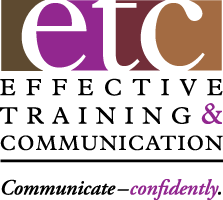If I only had time to teach my executive coaching clients one delivery skill, it would be to maximize their eye contact. Properly done, engaging your eyes produces several positive results for your audience … and for you. Nothing says more about your credibility, power and confidence than what you do – and don’t do – with your eyes. Everything else is a ‘B’ priority.
Old Habits
First, we need to identify and overcome some bad habits. Many of us were taught to quickly scan the faces in a room when delivering a presentation. Unfortunately, scanning results in your visual over-stimulation, increases nervousness and makes it harder to think clearly. As a result, you forget your message at times and utter lots of vocalized pauses – ‘ums’ and ‘ahs’. The audience can tell that you’re not comfortable looking them in the eye – not a good thing for your image.
Some people who are uncomfortable looking directly into the eyes of audience members may try to avoid it by looking at their shoulders or, even worse, by staring at a spot high on the back wall. Either practice also projects lack of confidence and the avoidance is obvious to the audience. So, it’s a Lose-Lose strategy.
Control Your Eyes
Evolve beyond simple eye contact to Eye Control – and control where your eyes go and for how long. Look at one person at a time for 8 – 10 seconds or enough time for one or two short sentences. Then, move in silence to a new person in a random manner. During your silent move, take a breath and think of what to say next. This technique can also significantly reduce your vocalized pauses.
Because Eye Control helps you limit the amount of visual input going to your brain, it can reduce nervousness and interference with clear thinking. It can also reduce the stress that comes from speaking to a large audience, because it creates the emotional illusion that you’re talking to one person at a time.
You Win – They Win
Properly done, it makes it easier for the audience to pay attention because it seems like you’re talking with each of them in turn. It also slows down your delivery pace – another good thing. The Eye Control mantra is ‘Only talk to faces!’ If you need to look at your notes or the screen to remember what to say next, that’s fine. Just do so in silence.
Since Eye Control may be different from what you were originally taught, it takes some time to get comfortable with it. With some practice, it will become more natural and you’ll be surprised at the results: engaging the audience, projecting more confidence, decreasing stress, decreasing vocalized pauses and slowing down your delivery.
Now you know why engaging your eyes by controlling where you look and for how long is the most important delivery skill. Best wishes for success in adding it to your Workplace Presenter Tool Kit.
